The Safavid Empire, which was founded as a political dynasty in 1501, was the second Great Islamic Empire to form. It originated as a religious sect, and it acquired the military and political traits of an empire only after 1501. The Safavid Empire also differed from the Ottoman and Mughal Empires because it was an official Shi’ite empire. religious differences led to much hostility between the Safavids and its Sunni rivals. The Safavid Empire was formed in 1501 and ended by the invasion of Afghans in 1722. It forever influenced Persian nationalism.
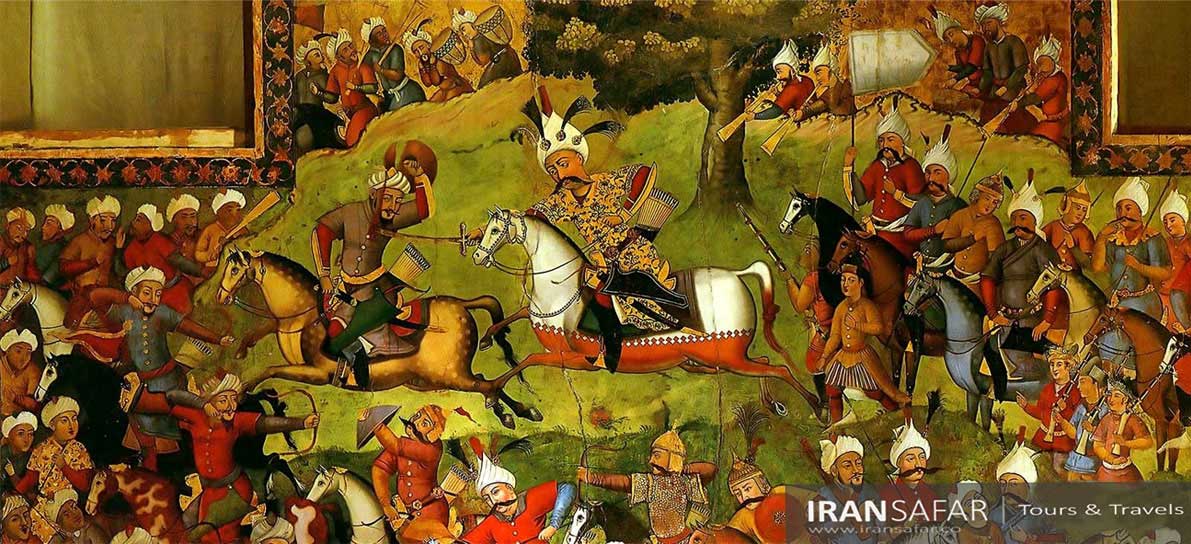 Painting at Chehelsotoun Palace, Isfahan
Painting at Chehelsotoun Palace, Isfahan
Who were Safavids?
Safavids (1501–1736), the dynasty that took control of Persia in the early 16th century, is often considered the beginning of modern Persian history. Safavid’s establishment of Twelver Shiʿism as the Iranian state religion was a major factor in the emergence of a united national consciousness among the various ethnic and linguistic elements of the country.
The Origins of the Safavid Empire
The roots of the Safavid Empire trace back to the Safavid Order, a Sufi religious movement founded by Sheikh Safi al-Din in the 13th century. As Shi’ism spread during the 15th century, so did the Shi’ite Sufi orders, and their forces increased. The oldest Shi’ite sufi order at this time was attributed to the Safavid Sufi family, descendants of Sheikh Safi al-Din of Ardabil – head of the Sufi order of Safavid– who gradually established power in Azerbaijan region and the surrounding area. They provided a monarchy-like system until, as we know, they came to the kingdom of Iran at the beginning of the 16th century.
Originally a spiritual order, the Safavids gradually amassed military power, eventually transitioning into a ruling dynasty. Sheikh Safi al-Din’s descendants, particularly his great-grandson Ismail I, were pivotal in transforming this religious order into a formidable political force.
Throughout the Iranian history, the emergence of the Safavid dynasty is an important turning point; after centuries of being under control of foreign rule, Iran is once again becoming a powerful and independent state in the Islamic East. The Mongol invasions that began in the 13th century drastically reconfigured the Islamic world. Not only did the invasions bring about the end of the Abbasid Empire and leave the center of Islamic world fractured, but the arrival of new Turkic peoples and dynasties throughout much of Islamdom shifted the axes of power into the hands of Turkic clans. The Ṣafavi order at Ardabil, however, was distant enough from any political center to remain neutral, allowing the Persian mystics to build a strong following of their own.
Also Read: Sasanian Empire
Safavid Empire’s Religion
Through their remarkable achievements, the Safavids reunified Iran as an independent state in 1501 and established Twelver Shi’ism as the official religion of Persia, marking one of the most important turning points in the history of Islam. Twelvers believe that the Twelve Imams are the spiritual and political successors to Prophet Muhammad. According to this theology, the Twelve Imams are exemplary human individuals who not only rule over the community with justice, but are also able to preserve and interpret Shari’a and the esoteric meaning of the holy Quran. The words and deeds (Sunnah) of Muhammad and the Imams are a guide and model for the community to follow; as a result, Prophet Muhammad and the Imams must be free from error and sin, a doctrine known as Ismat or infallibility.
The Establishment of the Safavid Empire
Ismail I, who ascended to power in 1501, is credited with founding the Safavid Empire. He declared himself Shah of Iran and made Twelver Shi’a Islam the official state religion, marking a significant shift in the region’s religious landscape. The Battle of Chaldiran in 1514 against the Ottoman Empire was a turning point in Safavid history. Although the Safavids were defeated, this battle established the borders between the two empires and highlighted the resilience and determination of the Safavid rulers.
 Ismail I, the founder of Safavid Empire
Ismail I, the founder of Safavid Empire
Shah Isma’il I Safavid (r. 1501-24)
It was under Ismāʿil I (r. 1501-24), that the Safavids evolved from a spiritual movement to a political dynasty led by a shah rather than a Sheikh. This was achieved with the assistance of the Qizilbāsh, who venerated their leader as an incarnation of God and were blindly obedient to him, even offering themselves for martyrdom in his cause.
They could put 70,000 armed horsemen in the field at one time. Some became mercenaries, but most of them supported the Safavid shahs who were fighting against the Sunni Ottoman and Sunni Uzbek Turks. By the death of Sheikh Heydar in 1488 in a battle, civil war in Azerbaijan ensued. In 1501 Heydar’s son, Esma’īl, founded the Safavid dynasty and conquered most of what is Iran today. Shah Isma’īl spread Twelver Shiʿism (belief in twelve Imams) throughout Persia, the religion that is still dominant in Iran today.
With Azerbaijan seized, Esmaʿil, barely 15 years of age, inaugurated Safavid political rule in 1501 by proclaiming himself king in Tabriz, having coins struck in his name and declaring the city his capital.
In August 1514 Ismaʿīl was seriously defeated at Chaldoran by his Sunni Turkish rival, the Ottoman Sultan Selim I. Thereafter, the continuing struggle against the Sunnis—the Ottomans in the west and the Uzbeks in the northeast—cost the Safavids Kurdistan, Diyarbakır, and Baghdad, while Tabriz was continuously under threat. Iran weakened appreciably during the reign of Ismaʿīl’s eldest son, Shah Tahmasp I (1524–76), and persistent and unopposed Turkmen forays into the country increased under his incompetent successors.
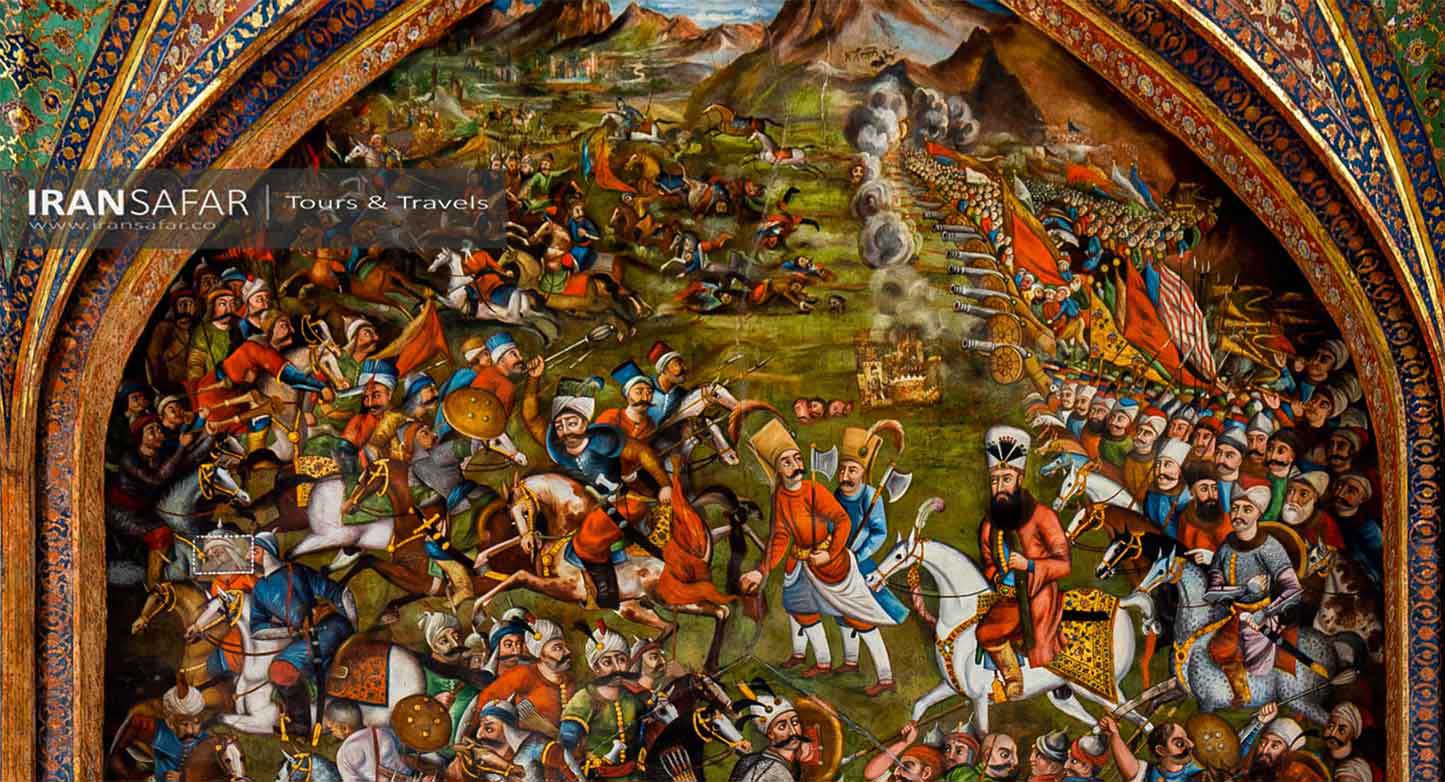 Painting demonstrating the Chaldoran battle, Chehel Sotoun Palace, Isfahan, Iran
Painting demonstrating the Chaldoran battle, Chehel Sotoun Palace, Isfahan, Iran
Chaldoran Battle
In the early 16th century, two empires competed for eastern Turkey and Iraq and Greater Syria. On one side was the Ottoman Empire settled in western Turkey and Constantinople (Current Istanbul). On the other side was the Safavid Empire, leaded by Shah Isma’il who began with a series of conquests in Azerbaijan and northwestern Iran. Nine years later, Shah Ismail conquered the entire plateau of Iran and also Baghdad. The sudden expansion of the Safavid Empire posed a serious threat to the Ottomans, prompting Sultan Selim I to confront the Safavids. Ottoman troops suppressed the Turkic tribes of eastern Turkey and reached Chaldoran, where the Safavids and Ottomans fought each other on 23 August 1514.
Ottomans won the battle with the help of artillery technology and this victory strengthened the Ottoman rule in Kurdistan and Iraq. The Safavids, who relied heavily on cavalry and minimal use of artillery, were shocked by their defeat. But the important point was that the Battle of Chaldoran had a huge effect on the formation of the modern Middle East. The defeat of the Safavids at Chaldoran prevented the establishment of a vast empire in the Middle East because they failed to take control of eastern Turkey and Iraq. This event led to the formation of today’s borders between Iran, Turkey and Iraq.
The Golden Age of the Safavid Empire
The reign of Shah Abbas I, from 1588 to 1629, is often considered the golden age of the Safavid Empire. Shah Abbas I implemented a series of reforms that strengthened the military, economy, and central administration. He moved the capital to Isfahan, transforming it into a hub of culture, architecture, and commerce. Under his rule, the empire saw unprecedented growth in trade, particularly along the Silk Road, and a flourishing of the arts, with Isfahan becoming one of the most beautiful cities in the world.
The city’s landscape was enriched with magnificent Persian gardens, designed with intricate layouts, flowing water, and lush greenery, symbolizing paradise on earth. Persian poetry also thrived during this period, with poets drawing inspiration from the grandeur of Isfahan and the Safavid court’s patronage of the arts. Iranian culture flourished, blending traditional Persian customs with new influences from trade and diplomacy.
Shah Abbas I (r. 1588-1629)
In 1588, Abbās I (the great) was crowned. Realizing the limits of his military strength, Shah Abbas made peace with the Ottomans on exceptional terms in 1590 and directed his destructive attacks against the Uzbeks. Meeting with little success, Abbas engaged in a major army reform. The strength of the “Qizilbash” was reduced, while the use of firearms was expanded. The young king equipped the Iranian army with artillery and rifles with the help of the British “Shirley Brothers“, and took the position of commander from effete Qizilbash.
Three bodies of troops were formed, all trained and armed in an early modern manner and paid out of the royal treasury: the Ghulāms (slaves), the Tofang-chīs (musketeers), and the toop-chīs (artillerymen). With his new army, ʿAbbās defeated the Turks in 1603, forcing them to relinquish all the territory they had seized, and captured Baghdad. He also expelled the Portuguese traders who had seized the island of Hormuz in the Persian Gulf early in the 16th century.
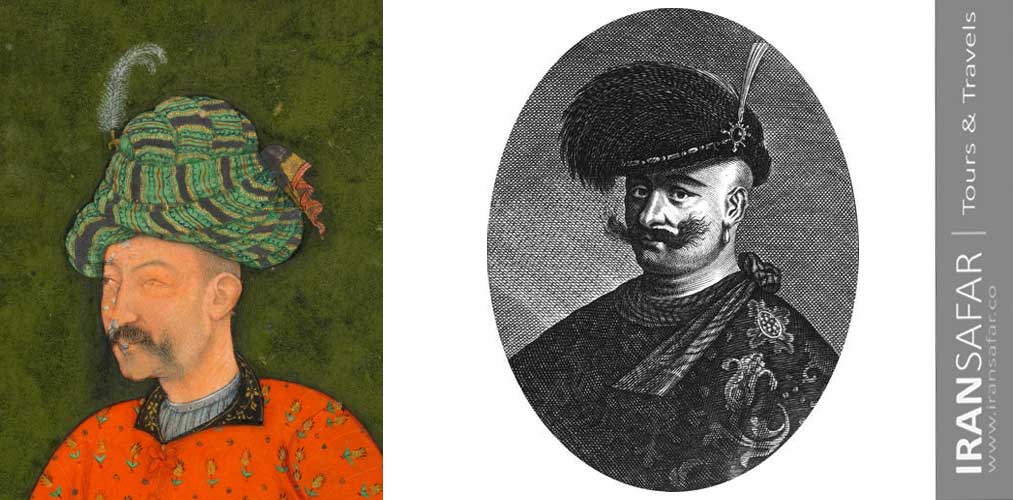 Shah Abbas the Great
Shah Abbas the Great
Shah Abbas’s remarkable reign, with its striking military successes and efficient administrative system, raised Iran to the status of a great power. Trade with the West and industry expanded, communications improved. He moved the capital from Qazvin to Iṣfahan and made it the center of Safavid architectural achievement, manifest in the Shah Mosque of Isfahan (called Masjed-e Imam after the 1979 Iranian Revolution), Sheikh Loṭfollah mosque, and other monuments including the Aalī Qāpū, the Chehel Sotoon palace, and the Naqsh-e Jahan square. Despite the Safavid Shiʿit zeal, Christians were tolerated and several missions and churches were built in Isfahan’s Julfa neighborhood. He also ordered to construct over a 1000 caravanserais on the silk road and some of the best Bazaars in Iran.
Also Read: Famous cravanseraies of Iran
Capital replacement
In 1598, Abbas the great moved the Safavid capital to Isfahan from Qazvin, which had itself taken over from Tabriz, on the Ottoman border, 50 years earlier. Isfahan was located in the center of Persia, and thus it was not as vulnerable to attack as Tabriz or Qazvin. Abbas adorned Isfahan, which had also been the Seljuk capital centuries earlier. Under Abbas, Isfahan became one of the world’s greatest cities.
Along with huge urban construction projects, his government also helped artists, financed production of carpets and textiles in state workshops and settled 300 Chinese potters and their families in Iran to capitalize on the vogue for Chinese ceramics. He then invited the Armenians (who faced troubles due to the Ottoman-Safavid War of 1603-1618), and settled them in New Julfa neighborhood of Isfahan. Armenians controlled much of the Persian international silk trade, so the king gave them the monopoly on silk exports. Abbas also created a new standing army to guard the borders and the caravan roads and re-stabilized the country’s territories which helped the traders to feel safe investing in the country.
The Safavid Empire Military
The Safavids were one of the most important dynasties in Iranian history, ruling from 1501 to 1736 (Technically 1722). To maintain their power and expand their territory, they established a strong and organized military. The Safavid army was a combination of traditional Iranian forces and newly formed military units inspired by the experiences of other empires, especially the Ottomans.
Main Units of the Safavid Military
Qizilbash (Red Heads): The Qizilbash were the backbone of the Safavid military in the early years. They were Turkic warriors loyal to the Safavid shahs and played a crucial role in the establishment of the empire. However, their power sometimes became a threat to the authority of the kings, leading later rulers to reduce their influence.
Ghulams (Slave Soldiers): The Safavids created a special military unit called Ghulams, similar to the Ottoman Janissaries. These soldiers were usually Christian boys taken from the Caucasus region, converted to Islam, and trained as elite warriors. They were highly loyal to the king and helped balance the power of the Qizilbash.
Regular Infantry and Artillery: During the reign of Shah Abbas I (1588–1629), the Safavid army was modernized. European firearms and cannons were introduced, and a standing army with professional soldiers was established. This allowed the Safavids to compete with the Ottomans and Uzbeks, who also had powerful armies.
Cavalry: Iranian cavalry had always been an important part of Persian military tradition. The Safavid cavalry included both Qizilbash warriors and other groups such as local Persian horsemen. They played a key role in battles and protecting the empire’s vast borders.
Strengths and Weaknesses of the Safavid Military
The Safavid military was strong in its use of cavalry, its ability to adapt to new weapons, and its combination of different ethnic and social groups. However, internal conflicts, reliance on tribal forces, and a lack of continuous modernization made them vulnerable in the long run. By the early 18th century, the army was unable to resist Afghan and Ottoman invasions, leading to the fall of the Safavid Empire in 1722.
Despite their decline, the Safavids left a lasting impact on Iranian military organization, and their efforts in creating a professional army influenced later Persian dynasties.
Safavid Dynasty Empire Map
The Safavids ruled from 1501 to 1736. At their height, they ruled over all of what is now Iran, Azerbaijan Republic, Bahrain, Armenia, eastern Georgia, parts of the North Caucasus, Iraq, Kuwait, and Afghanistan, as well as parts of Turkey, Syria, Pakistan, …
The Safavid Empire Flag
The Safavid Empire’s flag evolved over time, but it consistently featured elements that reflected the empire’s Persian identity and Shi’a Muslim faith. One of the most recognized flags of the Safavid Empire was a green flag, symbolizing Islam. The flag often included a depiction of the “Lion and Sun” motif, which has deep roots in Persian culture. The lion represented strength and courage, while the sun symbolized kingship and divinity.

Fall of the Safavid Dynasty
After Shah Abbas the Great died in 1629, his successors ruled for about a century, but, except for an interval during the reign of Shah Abbas II (1642–66), it was a period of decline.
In the late 17th and early 18th centuries, the Safavid Empire began to break up. Since peace was made with the Ottoman Empire, there was no longer a need for strong military forces. As a result, further fragmentation took place in the empire. In addition to this, the following kings who came in power became more and more incompetent. During the reign of Shah Soleiman, who ruled from 1667 to 1694, famine and disease spread throughout the country. His successor Shah Sultan Hossein (r.1694 to 1722) was the main cause of the end of the Safavid Empire. He appointed a member of Shia’a religious establishment, Mohammad Baqir Majlesi, to top positions. Majlesi and some of the Shia’a clergy slowly took control of the empire and overthrew the regime. Sultan Hossein’s rule was relatively peaceful until he faced a huge revolt in Afghanistan, in the easternmost part of his kingdom.
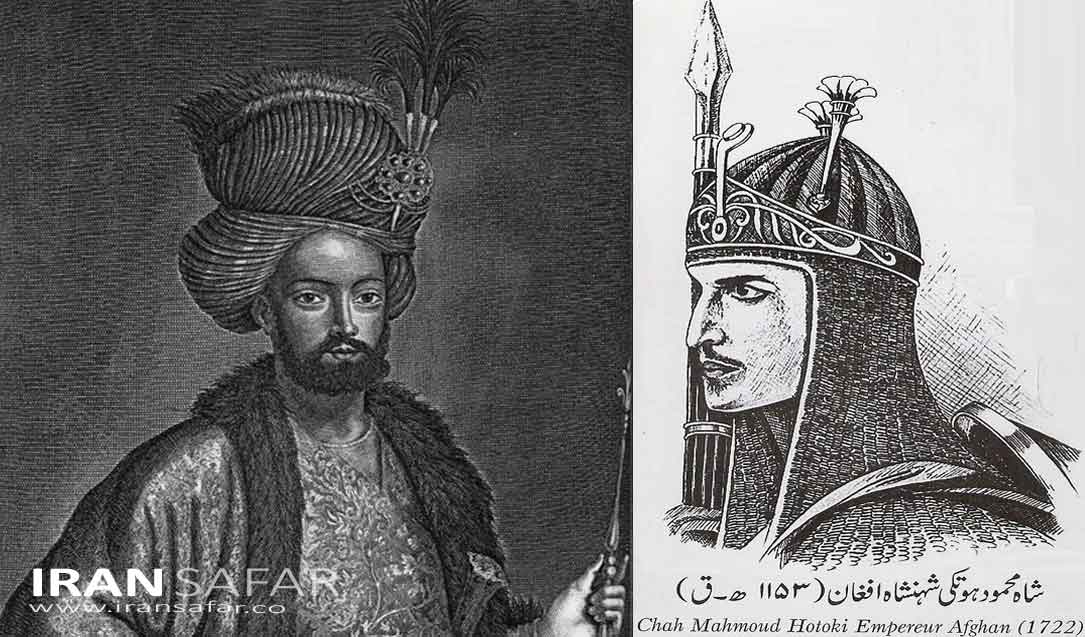 Left: Shah Sultan Hossein Safavid | Right: King Mahmoud Afghan
Left: Shah Sultan Hossein Safavid | Right: King Mahmoud Afghan
At that time, the Afghans were divided into two major tribes: the Ghilzais and the Abdalis. In 1709, the Ghilzai Afghans of Qandahar, under their leader Mirwais, rebelled and successfully broke away from Safavid rule. In 1722, Mirwais’s son Mahmud and his army swept westward aiming at Iranian capital Isfahan itself.The king was urged to escape to the neighboring provinces to gather more troops but he decided to remain in the capital which was now surrounded by the Afghans. Mahmud’s siege of Isfahan lasted from March to October, 1722. Starvation and disease finally forced Isfahan into submission (it is estimated that 80,000 of inhabitants died during the siege). On 23 October, Sultan Hossein abdicated and submitted the crown to Mahmud Afghan as the new shah of Persia. At the same time, the Ottomans and the Russian Peter the great began seizing territories in Iran and the Safavid Empire came to a complete end in 1736.
Seven years after that Iṣfahan fell to the Ghilzai Afghans of Qandahar, Sultan Hussein’s son, Tahmasb II recovered Iṣfahan and ascended the throne, only to be deposed in 1732 by his army general Nader Gholī Beig (the future Nadir Shah Afshar)
Comparison with Other Islamic Empires
The Safavid Empire is often compared to its contemporaries, the Ottoman and Mughal Empires. While all three empires were Islamic and shared similarities in governance, culture, and military organization, the Safavids were unique in their establishment of Shi’a Islam as the state religion. This religious distinction set the Safavid Empire apart from its Sunni neighbors and played a key role in shaping its identity and policies.
Safavid Art
Usually in Iran, the royal family and people from the upper social classes applied for works of art and helped it to flourish. The Safavid kings were also lovers of art, and some of them, such as Shah Tahmasp I and prince Sam Mirza, were themselves expert artists and held art in high esteem. The Safavids in many cases, especially in terms of painting, inherited the art of the Timurids. Manuscript illustration was prominent in royal patronage. Tahmasp who had been trained in painting at an early age, was an active patron of the arts of the book. During his reign, one of the aspects of the art of painting, namely Miniature Art, reached perfection and the king himself spent a lot of time learning it. Most of the prominent artists of that era were considered to be the king’s friends or of his courtiers. Shah Tahmasb was also very skilled in Tazhib.
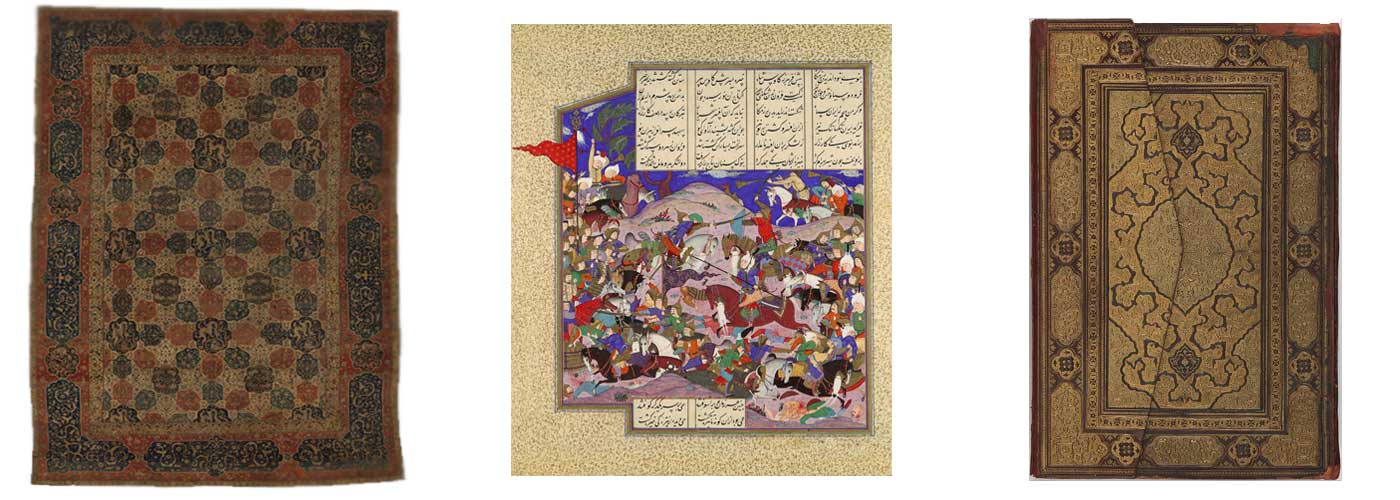
The most distinguished of Safavid rulers and the greatest patron of the arts was Shah Abbas I. His reign was recognized as a period of military and political reform as well as of cultural florescence. Shah Abbas did not have such an attachment to painting, instead, he paid much attention to architecture and urban planning. In terms of technical characteristics, the art of painting changed during the Safavid rule. For example, instead of portraying heroes and myths, much attention was paid to depict aspects of ordinary people’s life.
Safavid Carpets
The summit of Persian carpet design and production was truly attained under the Safavid empire (1502-1739). It was the result of a unique concurrence of royal patronage, the influence of court designers at all levels of artistic production, the wide availability of both local and imported materials such as high quality dyes, and market acceptance, particularly in Europe.
Although almost no example of 15th century Persian textile survives today, the high level of quality achieved early in the Safavid period can be confirmed by foreign travelers who visited Iran in Safavid times. On the other hand, emergence of carpets in 15th century Iranian paintings suggest that a developed carpet-weaving industry already existed in the century before the Safavids came in power. Surviving Safavid carpets represent both court production (carpets manufactured to court standards but not necessarily used at the court) and commercial production, which often reflects courtly tastes. Carpets were woven in palace workshops and on urban and village looms. No example of a nomadic rug remains from the Safavid era, but such carpets surely existed well before courtly and commercial interests engendered an urban industry.
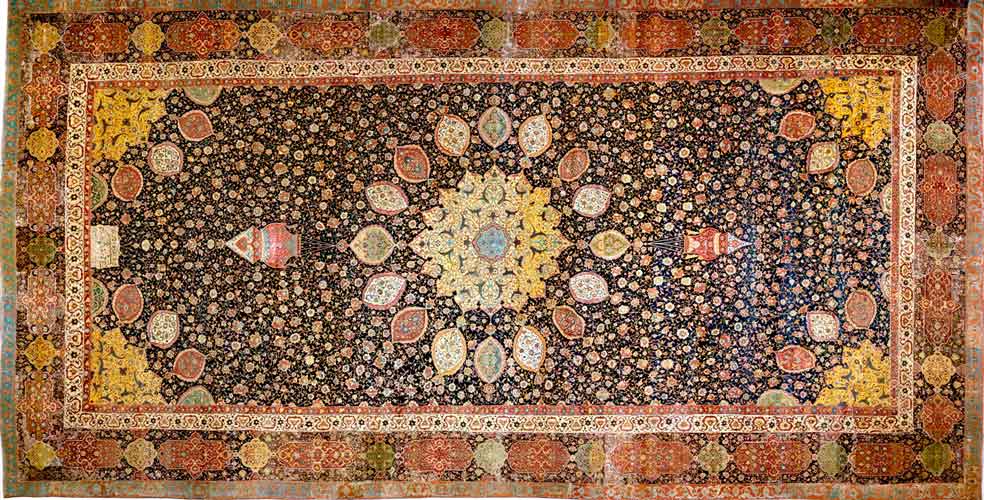 The Ardabil Carpet (1539), Victoria and Albert Museum, London.
The Ardabil Carpet (1539), Victoria and Albert Museum, London.
Fast Facts About the Safavids
Establishment: The Safavid Empire was founded by Shah Ismail I in 1501 after defeating the Aq Qoyunlu and declaring Twelver Shi’a Islam as the official religion of Iran.
Religion: The Safavids played a key role in making Shi’a Islam the dominant sect in Iran, shaping its religious identity to this day.
Golden Age: The empire reached its peak under Shah Abbas I (1588–1629), who modernized the army, strengthened the economy, and made Isfahan a center of art and architecture.
Military: The Safavid military included Qizilbash warriors, Ghulam slave soldiers, and a modernized standing army equipped with firearms and cannons.
Architecture: The Safavids built stunning landmarks like Sheikh Lotfollah Mosque, Naqsh-e Jahan Square, and Shah Mosque in Isfahan.
Trade & Economy: The Safavids controlled important trade routes, including the Silk Road, and were famous for Persian carpets, silk, and ceramics.
Rivalries: They were in constant conflict with the Ottoman Empire in the west, the Uzbeks in the northeast, and the Mughals in the east.
Decline: The empire weakened due to weak rulers, internal conflicts, and Afghan invasions, leading to its fall in 1722 when the Afghans captured Isfahan.
Safavid Empire Timeline
-
〇 ISMAIL I
1501-1524
Establishment of the empire
-
〇 Battle Chaldoran
1514
Iran defeated
-
〇 TAHMASP I
1524-1576
-
〇 Ottomans capture Baghdad
1533
-
〇 ISMAIL II
1576-1578
-
〇 SULTAN MOHAMMAD
1533
-
〇 ABBAS I
1588-1629
Isfahan chosen as capital
-
〇 SAFI I
1629-1642
-
〇 ABBAS II
1642-1666
-
〇 SULEIMAN I
1666-1694
-
〇 SULTAN HOSSEIN
1694-1722
-
〇 AFGHAN INVASION
1722
Isfahan captured
-
〇 TAHMASP II
1722-1732
-
〇 TAHMASP II deposed
1732
by Nader Gholi
-
〇 ABBAS III
1732-1736
Nader rules as Regent
-
〇 NADER
1736
End of Safavid Empire
Safavid Empire – FAQ
What was the Safavid Empire famous for?
The Safavid Empire, which ruled Persia (modern-day Iran) from 1501 to 1736, is famous for several key aspects: Shi’a Islam as State Religion, Cultural Flourishing, Military Power and Gunpowder, Trade and Diplomacy, Architectural Achievements.
Why did the Ottomans hate the Safavids?
The two states were the greatest powers of West Asia. The Ottoman Empire had several reasons for its deep-seated hostility toward the Safavid Empire, which stemmed from a combination of religious, political, and territorial factors: Religious Differences: The Ottomans were Sunni Muslims, while the Safavids were ardent proponents of Twelver Shi’a Islam. Territorial Rivalry: Key areas of conflict included Mesopotamia (modern-day Iraq) and eastern Anatolia. Political Power Struggles: Both empires aspired to be the dominant power in the Islamic world.
What was the significance of the Battle of Chaldoran?
The Battle of Chaldoran in 1514 was a crucial conflict between the Safavid Empire and the Ottoman Empire. It marked the beginning of a long-standing rivalry between the two powers and established the borders between them. The battle also highlighted the Safavid Empire’s military resilience despite its defeat.
How did the Safavids contribute to Persian culture?
The Safavid Empire was a golden age for Persian art, architecture, and culture. They promoted the development of Persian literature, visual arts, and architecture, leaving behind iconic monuments like the Shah Mosque in Isfahan. Their patronage of the arts significantly enriched Persian cultural heritage.
What role did Isfahan play in the Safavid Empire?
Isfahan became the capital of the Safavid Empire under Shah Abbas I. It was transformed into a cultural and economic hub, known for its stunning architecture, including palaces, mosques, and bridges. Isfahan’s grandeur symbolized the empire’s wealth and artistic achievements.
Why did the Safavid Empire decline?
The decline of the Safavid Empire was due to a combination of internal strife, weak leadership, succession issues, and external pressures from neighboring powers like the Ottomans and Afghan invaders. These factors led to the eventual collapse of the empire in the early 18th century.
How did the Safavid Empire influence modern Iran?
The Safavid Empire’s establishment of Twelver Shi’a Islam as the state religion had a profound and lasting impact on Iran’s national identity and religious landscape. The cultural and architectural achievements of the Safavid era continue to shape modern Iranian society and heritage.
What are the masterpeaces of Safavids in Isfahan?
Under his leadership, Isfahan became famous for its stunning architecture, including Naqsh-e Jahan Square, Sheikh Lotfollah Mosque, and Ali Qapu Palace. The city was designed with Persian gardens, grand bazaars, and elegant bridges over the Zayandeh Rud River.
Isfahan’s Persian hammams (bathhouses) also reflect the rich Iranian culture. The Safavids’ efforts made Isfahan so beautiful that people said: “Isfahan is half the world” (Isfahan nesf-e jahan).

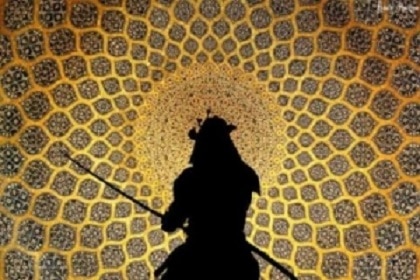
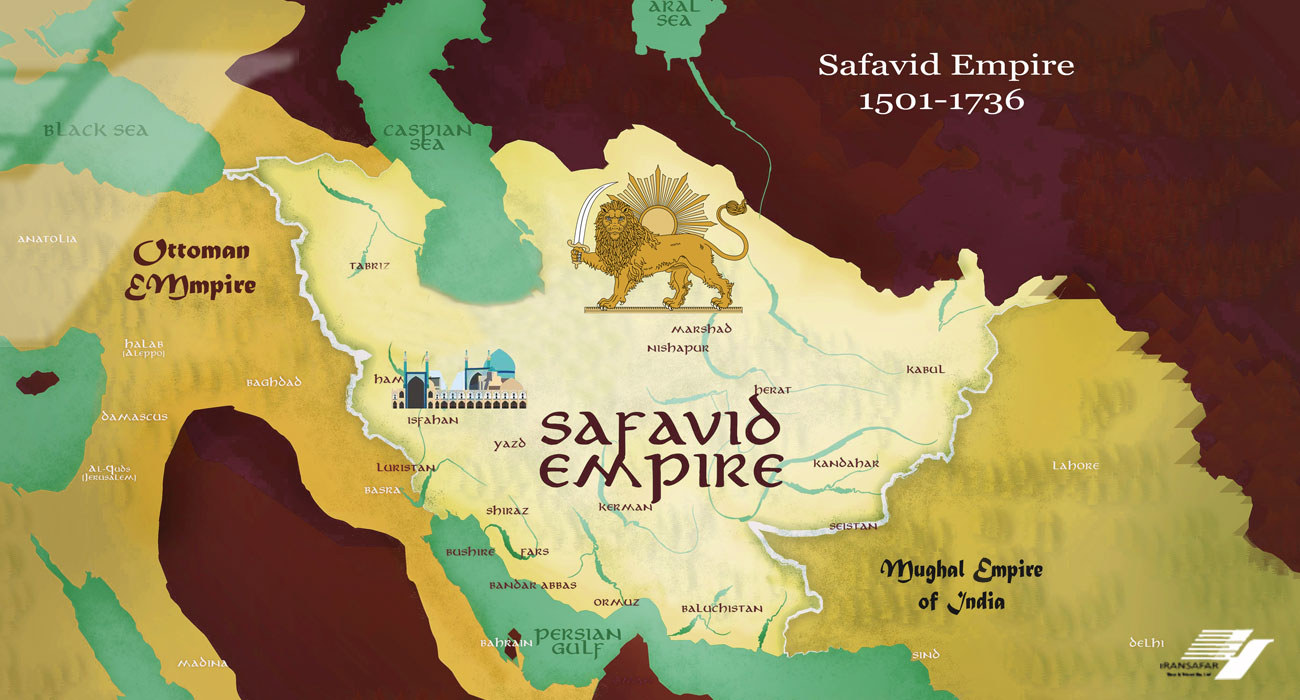
Wrote: Armen Rzayev
The Safavid Empire played a significant role in shaping the cultural, religious, and political landscape of Azerbaijan. As a key region within the empire, Azerbaijan became a center for the spread of Shia Islam, which remains a dominant faith in the country today. The Safavids also fostered the development of Azerbaijani literature, art, and architecture, leaving a lasting legacy that is still evident in the region’s cultural identity. The empire’s influence helped to unify the diverse peoples of Azerbaijan under a shared religious and cultural framework, which contributed to the formation of a distinct Azerbaijani identity that endures to this day